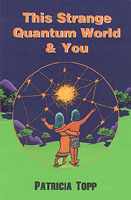 This Strange Quantum World and You
This Strange Quantum World and You This Strange Quantum World and You
This Strange Quantum World and YouThis Strange Quantum World and You is a book for those from 9 to 90 who wish to gain some understanding of this quantum world. This smaller-than-an-atom world can be known only be suggestion.
This book is geared toward children and suggests a few simple experiments to learn how the energy and the material part of our universe may work and that they are really different states of the same thing. We discover how information is carried in such a way as to make everything and everybody a part of a spiritual universe which is ONE. This leads children to a feeling of belonging. It also illustrates the necessity of watching how we think, speak, and act, so that we do a more responsible job of caring for our Earth and for each other.
|
Endorsements |
"Patricia Topp has done a remarkable job of translating the language of quantum physics into one that a child can understand." Fritjof Capra, author of The Tao of Physics
"Patricia Topp's book offers a bridge between the world of form and matter's true essence. Easy to read, it offers a straightforward understanding in an area of previous wonder. Having been an educator for over two decades, I plan to use this book and its experiments with my 4th grade class." Laurel Petersen
"After reading This Strange Quantum World & You, I understood a lot more about science than I used to. The drawings and experiments help to give a more clear idea of what's being explained. This book makes reading about a tough subject fun and easy to understand." Natalie Nix, 7th grade student
"This book flows from science to the beyond. Quality, thoughtful reading for children from eleven to one hundred and eleven." Terry Turk, M.S., M.A., L.P.C.
|
Table of Contents |
1. The Atomic Age Begins With a Bang
2. Discoveries About Light in the 1800s
3. What Is This Strange Quantum World?
4. Particles/Waves
5. What Is Solid?
6. Information Networks
7. Now You See It; Now You Don't
8. Caught in the Web
9. Faster Than the Speed of Light
10. What's It to You?
|
Excerpt |
More than two thousand years ago the Greeks talked of the universe as being made of tiny marble-like things, which they called atoms. For many years this seemed to be a useful way to view the world.
Then, scientists of the 1800s began to change their thinking about atoms being solid. They thought that each atom must be more like a small solar system with a center like a little sun. They called this center the nucleus. They thought even smaller particles circled, like planets on their paths around this sun. They called these tiny specks electrons. Like our solar system, the atoms were made mostly of great spaces. Their parts were thought to be held together by a force like the one you can feel when you put the south and north poles of two magnets close together.
The scientists believed that they could find out how most things in the world worked if they could study these atoms. No one knew whether the scientists were right or wrong about this. Even after the first microscopes were invented, the atoms proved to be too small to see.
Is it crazy to believe in a world that you cannot see? Many scientists did not think so. In the early 1900s, they made many discoveries even in the smaller-than-an-atom world.
And then along came Professor Einstein! He did not use a microscope. He just put on his thinking cap and came up with all sorts of strange ideas about energy and the solid stuff of the universe, which is called mass or matter.
Einstein thought that matter could be changed into energy. This idea was expressed in his now famous rule, E=mc2. This meant that if you take the speed of light (c), multiply it by itself, and multiply again by some mass (m) of stuff, you would get energy (E). Energy in a big way!
Multiplying by the speed of light will get you a big number. Light was thought to be the fastest thing in the universe. It speeds along at 186,000 miles (or 300,000 km) per second. That would be fast enough to shoot a rocket ship more than seven times around Earth in one second!
Scientists working with Professor Einstein's rule did find that great amounts of energy were set free even when they exploded very small amounts of matter. They found that atoms could be split right apart, making even smaller parts. Two atomic bombs made by using Einstein's rule were used during World War II to destroy two very large cities. With these two blasts the world entered the Atomic Age.
Blue Dolphin Publishing, 1999